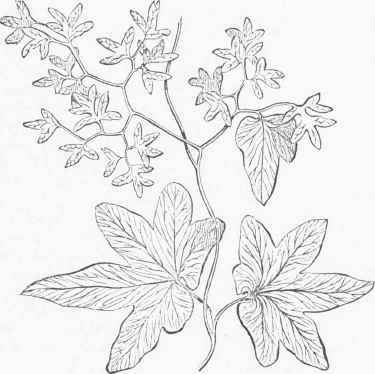Lygodium
Description
This section is from "The American Cyclopaedia", by George Ripley And Charles A. Dana. Also available from Amazon: The New American Cyclopędia. 16 volumes complete..
Lygodium
Lygodium (Gr.![]() flexible), a genus of climbing ferns, with much divided leafy fronds, having stalked divisions in pairs, so that the frond appears like a slender stem bearing opposite, petioled leaves; the divisions of the frond are lobed, or sometimes even pinnate; the fructification is upon separate divisions, which are much narrower than the sterile ones, and bear upon the back two rows of scale-like indusia, each of which covers usually but a single spore case, which has a complete ring at the apex and opens by a longitudinal slit. There are a number of species, natives of warm countries, and extending to New Zealand, Japan, and North America. But one species (L. palmatum) is found on this continent; it extends from Massachusetts westward to Kentucky, and sparingly southward; in its eastern localities it is a rare plant, but in some parts of Kentucky it grows in abundance. The fronds, 1 to 4 ft. high, are from slender running root stocks; they climb upon bushes and tall weeds; the lower or sterile divisions, or frondlets, are round-heart-shaped and pal-mately five- to seven-lobed; the fertile ones, borne at the upper portion of the frond, are many times forked and form a terminal panicle.
flexible), a genus of climbing ferns, with much divided leafy fronds, having stalked divisions in pairs, so that the frond appears like a slender stem bearing opposite, petioled leaves; the divisions of the frond are lobed, or sometimes even pinnate; the fructification is upon separate divisions, which are much narrower than the sterile ones, and bear upon the back two rows of scale-like indusia, each of which covers usually but a single spore case, which has a complete ring at the apex and opens by a longitudinal slit. There are a number of species, natives of warm countries, and extending to New Zealand, Japan, and North America. But one species (L. palmatum) is found on this continent; it extends from Massachusetts westward to Kentucky, and sparingly southward; in its eastern localities it is a rare plant, but in some parts of Kentucky it grows in abundance. The fronds, 1 to 4 ft. high, are from slender running root stocks; they climb upon bushes and tall weeds; the lower or sterile divisions, or frondlets, are round-heart-shaped and pal-mately five- to seven-lobed; the fertile ones, borne at the upper portion of the frond, are many times forked and form a terminal panicle.
The great delicacy and grace of this fern make it much sought after for decorative purposes, for which it is used in both the fresh and dried state; it is employed to festoon picture frames, ornament white window curtains, and the like. One of the famous localities for this plant is at East Windsor hill, Conn., from which such large quantities were taken away yearly that an act was passed by the state legislature to prevent its extermination. The attempts to cultivate it frequently fail from the fact that the root stock is so fine and spreading that in taking up the plant this is in" good part left behind. With careful management it can be transplanted. Some of the exotic species are favorite greenhouse plants, but there is much confusion in regard to the names; they are to be found in collections as L. polymorphum, L. scandens, L. volubile, etc, and generally have their sterile divisions much cut and divided.

Lygodium palmatum.
Continue to:


